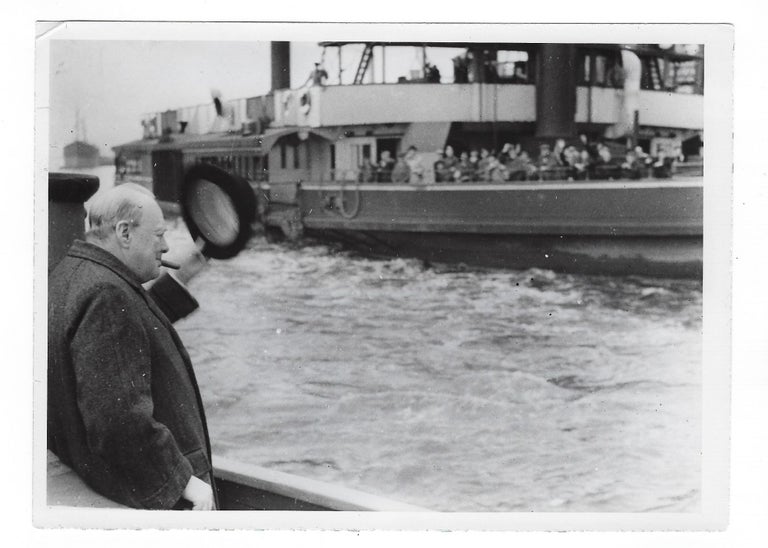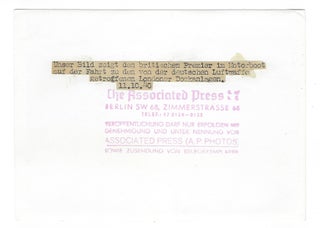A wartime press photograph from The Associated Press German Picture Service of Prime Minister Winston S. Churchill, the German caption stating that Churchill is depicted on his way to examine the Luftwaffe damage at the London docks on 11 October 1940
Berlin: Associated Press German Picture Service, 1940. Photograph. This wartime press photograph of Prime Minister Winston S. Churchill (1874-1965) belonged to the Associated Press German Picture Service, an American news agency on German soil that symbolized the imperfect struggle to maintain free press operations in Nazi Germany. The photo measures 5.25 x 7.25 inches (13.4 x 18.5 cm). Condition is very good, the glossy photo surface clean and bright with no tears or folds and light scratches visible only under raking light. A small crease in the upper left corner is confined to the margin. The verso features a typed German caption which translated reads "Our picture shows the British Prime Minister in a motorboat on the way to the London docking facilities hit by the German Luftwaffe". A stamp in pink ink reads “The Associated Press | Berlin SW 68, Zimmerstrasse 68 | Telef. 17 0124-0125” along with four further lines in German which translate to “Publication may only be made with the permission and appointment of Associated Press A. P. Photos along with the delivery of voucher copies”.
This photo is dated 11 October, 1940. “By six in the morning of October 16, the figure of those killed by air raids during the previous week was estimated at 1,567, of whom 1,388 were killed in London.” That same week, “German bombers had scored direct hits on the War office and the National Gallery.” On the afternoon of 15 October, discussing the intensification of air bombardment and the as-yet limited British ability to retaliate in kind, Churchill warned that the people of Britain “must stick it out”. (Gilbert, Vol. VI, pages 841-848)
When Churchill became Prime Minister on 10 May, 1940, the war for Britain was not so much a struggle for victory as a struggle to survive. From the fall of France to the formal entry of the United States, the outcome of the Second World War was not a forgone conclusion and Britain’s peril was quite real. Churchill’s first six months in office would see, among other near-calamities, the Battle of the Atlantic, the fall of France, evacuation at Dunkirk, and the Battle of Britain.
The threat of Nazi invasion of Britain was imminent and every boost to the morale and productivity of her citizens the potential difference. Churchill was known to visit sites of bomb damage and, in these visits, was frequently “totally fearless”. (Richard Langworth) He was also known to gather crowds, with whom he would become emotional. Later, his dear friend Lady Diana Cooper told him that his greatest achievement was giving people courage. “I never gave them courage,” he replied. “I was able to focus theirs."
The Associated Press (AP) established AP’s German photo service as a subsidiary in 1931. After 1933, the Nazis quickly brought the AP German photo service under the supervision of the Propaganda Ministry. Compromises were inevitable, including re-writing of AP captions and firing of Jewish AP employees in Germany. Nonetheless, “The AP made the difficult decision to comply because it believed it was critical for AP to remain in Germany and gather news and photos during this crucial period”. Berlin-based American AP reporters and German photographers covered the first part of the Second World War from 1939-1941 from the German side of the battle lines.
When the U.S. entered the war in December 1941, AP’s American staff members in Germany were arrested and interned for five months, while the AP German picture service was seized by the Nazi government and put under control of a Waffen SS photographer, Helmut Laux. Nonetheless, AP still wanted to make images of Nazi-controlled areas of Europe available to the American public, so with approval from the US Government a deal was brokered. Through a third party in neutral Portugal and Switzerland Bureau Laux and AP exchanged photos. Of course the captions for AP images that appeared in German publication were rewritten by Nazi propagandists, but the German photos obtained by AP in exchange helped AP to cover the war as comprehensively as possible and thereby give the U.S. public “a much fuller picture of the war than could have been obtained otherwise”. (AP). Item #004848
Price: $150.00


